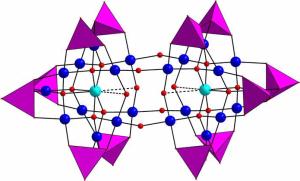 |
A couple of coppers: Two CuII ions exhibit highly distorted cubic coordination and unexpectedly large magnetic exchange coupling in a discrete dicopper(II)-containing 22-palladate(II). The compound is isolated as the hydrated sodium salt Na20[CuII2PdII22PV12O60(OH)8] 58H2O in which the polyanion (see structure: Cu turquoise, Pd blue, O red balls, {PO4} purple tetrahedra) is the largest noble metalate reported to date.
[Credit: Angewandte Chemie] |
Noble metal catalysts are of particular commercial importance, and among these catalysts, palladium- and platinum-containing materials have received particular attention in recent years owing to their role as oxidation catalysts in automobile emission control systems as well as reforming catalysts for the production of high-octane gasoline. Although these noble metal catalysts, which usually are employed as finely divided particulates with dimensions of about one to two nanometers, have been the object of intensive study for almost 200 years, their precise structure and composition still is mostly ill-defined on the sub-nanometer scale.
In 2008, the research group of Ulrich Kortz, Professor of Chemistry at Jacobs University and longtime expert in metal-oxide synthesis, made a landmark discovery when they developed a simple synthetic strategy, which, for the first time, allowed for the preparation of a discrete, stable noble metal oxide in water. This polyoxopalladate with its 13 palladium atoms and {Pd13O32} core structure turned out to be the forerunner of a family of highly reactive noble-metal oxides. It was the combination of several noble metal atoms with oxygen atoms in one ion that proved to be essential for the compound’s high reactivity and at the same time provided new insights into the detailed molecular mechanism of catalysis by noble metal particulates.
Now, Kortz and his co-workers Natalya Izarova and Maria Barsukova have achieved the synthesis of a discrete noble metal-oxide containing the record number of 22 palladium(II) ions with the formula [Cu2Pd22P12O60(OH)8]20– ({Cu2Pd22}). This species is the largest noble metalate reported to date, and in addition it contains two copper(II) ions, which makes it the first mixed palladium-copper polyanion.
The novel double-cuboid shaped metal-oxide cluster offers tremendous catalytic potential, mainly because all 22 PdII ions are located on its surface and hence are highly accessible for oxidants and substrates alike. “One single {Cu2Pd22} therefore has many catalytically active centers. And, compared to the more commonly used catalytic palladium metal coatings on support materials, our new palladium oxide has the additional advantage of being applicable in solution as a homogeneous catalyst as well as in crystalline form as a heterogeneous solid catalyst in liquid phase reactions. Especially these latter qualities predestine it for industrial purposes,” comments Ulrich Kortz on possible applications of the newly created compound. “Moreover, our new polyanion, because of its stable and discrete nature, also might pave the way for the fabrication of monodisperse palladium particles on supports, which are most effective catalysts for various reduction and oxidation processes, such as in fuel cells, which convert hydrogen and oxygen directly into electricity in a carbon-neutral process,” Kortz adds.
In addition to its high catalytic potential, {Cu2Pd22} also exhibits extremely interesting magnetic exchange interactions between the two central, but rather distant, copper(II) ions, which could be explored in detail because of the compound’s discrete and stable nature and the well characterized structure. As many solids and biological materials contain similar dimeric ion constellations, the magnetic results on {Cu2Pd22} open new perspectives for a better understanding of intramolecular magnetic phenomena of importance in materials and life sciences.



